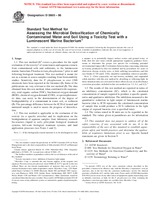Potřebujeme váš souhlas k využití jednotlivých dat, aby se vám mimo jiné mohly ukazovat informace týkající se vašich zájmů. Souhlas udělíte kliknutím na tlačítko „OK“.
ASTM D5660-96
Standard Test Method for Assessing the Microbial Detoxification of Chemically Contaminated Water and Soil Using a Toxicity Test with a Luminescent Marine Bacterium
Automaticky přeložený název:
Standardní zkušební metoda pro posuzování mikrobiální detoxikace chemicky kontaminované vody a půdy Používání test toxicity s luminiscenční mořské bakterie
NORMA vydána dne 1.1.1996
Informace o normě:
Označení normy: ASTM D5660-96
Poznámka: NEPLATNÁ
Datum vydání normy: 1.1.1996
Kód zboží: NS-32071
Počet stran: 8
Přibližná hmotnost: 24 g (0.05 liber)
Země: Americká technická norma
Kategorie: Technické normy ASTM
Anotace textu normy ASTM D5660-96 :
Keywords:
Bacteria/bacterial control, Bioluminescence, Bioremediation, Contaminated soil/water, Contamination,emenvironmental, Contamination,emwaste, Detoxification, Marine bacterium, Microbiological examination, P. phosphoreum , Soil, Toxicity/toxicology, Wastewater testing/treatment, Water, microbial detoxification,emchemically contaminated water/soil, using, luminescent marine bacterium, toxicity test,,Order Form, ICS Number Code 07.100.20 (Microbiology of water)
Doplňující informace
| 1. Scope | ||||||||||||||||||
|
1.1 This test method (1) covers a procedure for the rapid evaluation of the toxicity of wastewaters and aqueous extracts from contaminated soils and sediments, to the luminescent marine bacterium Photobacterium phosphoreum , prior to and following biological treatment. This test method is meant for use as a means to assess samples resulting from biotreatability studies. Sensitivity data for P. phosphoreum to over 1300 chemicals have been reported in the literature (2). Some of the publications are very relevant to this test method (3). The data obtained from this test method, when combined with respirometry, total organic carbon (TOC), biochemical oxygen demand (BOD), chemical oxygen demand (COD), or spectrophotometric data, can assist in the determination of the degree of biodegradability of a contaminant in water, soil, or sediment (3). The percentage difference between the IC20 of treated and untreated sample is used to assess the progress of detoxification. 1.2 This test method is applicable to the evaluation of the toxicity (to a specific microbe) and its implication on the biodegradation of aqueous samples from laboratory research bio-reactors (liquid or soil), pilot-plant biological treatment systems, full-scale biological treatment systems, and land application processes (see Notes 1 and 2). Note 1-If the biologically treated material is to be discharged in such a manner as to potentially impact surface waters and ground water, or both, then the user must consult appropriate regulatory guidance documents to determine the proper test species for evaluating potential environmental impact (4). Correlations between data concerning reduction in toxicity produced by this test method and by procedures for acute or short-term chronic toxicity tests, or both, utilizing invertebrates and fish (see Guides E729 and E1192), should be established, wherever possible. Note 2-Color (especially red and brown), turbidity, and suspended solids interfere with this test method by absorbing or reflecting light. In these situations data are corrected for these effects by use of an absorbance correction procedure included in this test method (see 5.3, 6.1, and 6.2).1.3 The results of this test method are reported in terms of an inhibitory concentration (IC), which is the calculated concentration of sample required to produce a specific quantitative and qualitative inhibition. The inhibition measured is the quantitative reduction in light output of luminescent marine bacteria (that is, IC20 represents the calculated concentration of sample that would produce a 20% reduction in the light output of exposed bacteria over a specified time). 1.4 The values stated in SI units are to be regarded as the standard. The values given in parentheses are for information only. 1.5 This standard does not purport to address all of the safety concerns, if any, associated with its use. It is the responsibility of the user of this standard to establish appropriate safety and health practices and determine the applicability of regulatory limitations prior to use. Specific hazard statements are given in Section 9. |
||||||||||||||||||
| 2. Referenced Documents | ||||||||||||||||||
|
Doporučujeme:
Aktualizace technických norem
Chcete mít jistotu, že používáte pouze platné technické normy?
Nabízíme Vám řešení, které Vám zajistí měsíční přehled o aktuálnosti norem, které používáte.
Chcete vědět více informací? Podívejte se na tuto stránku.




 Cookies
Cookies
